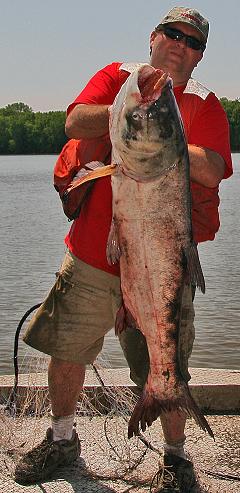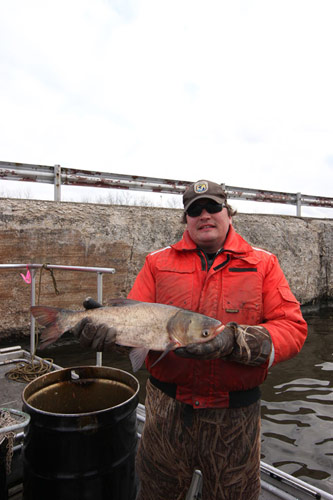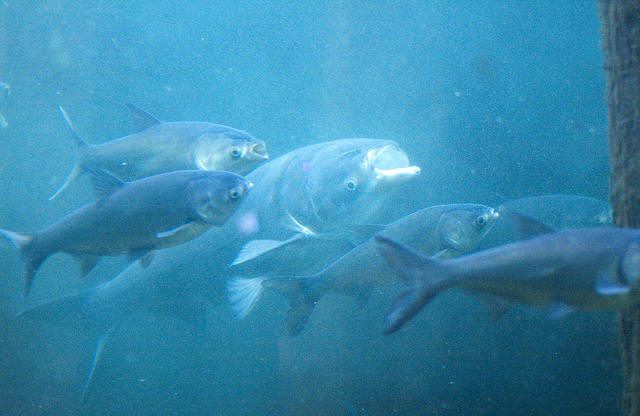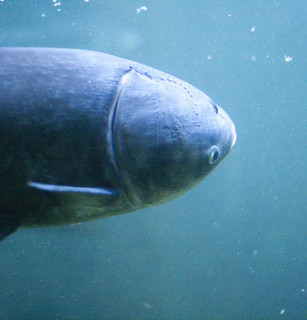Interactions
Interactions with the Bighead carp range far and wide.
These fish share their environment with numerous organisms
including bacteria, protists, fungi, animals, and many others.
Bighead carp
 are found to be both the prey and the predators.
They also can have some nasty parasitic relationships with other
organisms. Bighead carp are also known for competing with
other aquatic organisms found in their niche posing a problem
where Bighead carp are introduced as an invasive species.
First, we will start with the way Bighead carp interact with
prey.
are found to be both the prey and the predators.
They also can have some nasty parasitic relationships with other
organisms. Bighead carp are also known for competing with
other aquatic organisms found in their niche posing a problem
where Bighead carp are introduced as an invasive species.
First, we will start with the way Bighead carp interact with
prey.
Based on what we know about the Bighead carp diet they will prey on many zooplankton, blue-green algae, small aquatic larvae, and larger phytoplankton. Bighead carp can be known to take in a variety of small particles and other organisms. They can consume diatoms and other small protists in the water as well.
 Bighead
carp are not relatively high on the food, feeding a the small plankton
and algae. There are no known predators of the Bighead carp in the
United States because it is a newly introduced species in the
environment. Eagles and white pelicans have been seen catching
smaller adult and juvenile carp, and
Largemouth bass have been seen feeding on the small juveniles.
Researchers have predicted that other native predators are likely to
feed on the small Bighead carp before they reach larger sizes.
Bighead
carp are not relatively high on the food, feeding a the small plankton
and algae. There are no known predators of the Bighead carp in the
United States because it is a newly introduced species in the
environment. Eagles and white pelicans have been seen catching
smaller adult and juvenile carp, and
Largemouth bass have been seen feeding on the small juveniles.
Researchers have predicted that other native predators are likely to
feed on the small Bighead carp before they reach larger sizes.
Parasites: There are a few diseases and parasites associated with Bighead carp. A well-known disease among fish is caused by fungi Saprolegnia, known as "water moulds" for the cotton-looking growth off the skin of the fish. There is a disease called "White-skin disease" caused by the bacteria Pseudomonas dermoalba. As you can guess this disease whitens the skin at the base of dorsal fin and caudal fin, eventually leading to death. Bighead carp have many potential parasitic protozoans as well. These protozoans will develop in the gut and can cause the fish to be sluggish with a swollen, soft abdomen. There are a few Trematode species that can infect the gill filaments, skin, and eyes. Parasitic Cestodes like Bothriocephalus acheilognathi known as the Asian carp tapeworm can infect the intestines and potentially parasitize the fish.
Warning! Bighead carp are Invasive Species in the
U.S.A.

Bighead carp are considered invasive species in the United States. They are known to compete directly with other native fish and wildlife in freshwater lakes and rivers in the United States. Since Bighead carp are constant feeders they can cause a direct impact on zooplankton and algae levels, food that other native fish depend on to live and develop. There rapid growth and populating numbers can put strains on the environment and on the endangered species where they live with as well. Bighead carp do not have any known natural predators in the United states either so they can grow and reproduce unchecked. Bighead and other carp cause an estimated $7 billion in damages and costs to the economy of commercial, tribal, and sport fisheries. This is just one way they are viewed as causing harm.
You can help prevent this! Many people all over the United States are making efforts to control invasive species such as the Bighead carp. If you have questions or want to report a sighting of a Bighead carp or other invasive species contact your local DNR or the U.S. Fish and Wildlife Service. To make a report to the Wisconsin DNR click here. If you want to view a list of aquatic invasive species in Wisconsin click here. To learn more about invasive species in Wisconsin click this link. Also view the links below for more information on invasive species and ways to help.
To see a current list of injurious wildlife in the United States click here.
To see laws involving invasive species, transporting, and restrictions click here.
To view general information on aquatic invasive species click here.
To find answers about Frequently Asked Questions on invasive species click here.
The Bighead Carp as a Food Source? Although public opinion may vary from region to region, Bighead carp can in fact be consumed! These organisms make a nice food source for humans and thanks to quick growth and large size can provide relatively large quantities of flesh. Curious to learn more on how Bighead carp can make a nice meal? Continue on to the next link by clicking here.


